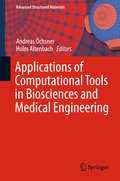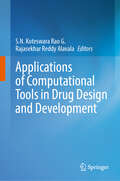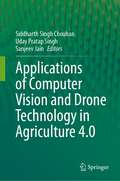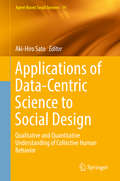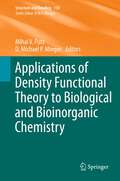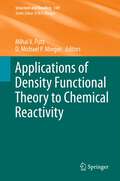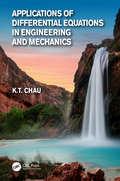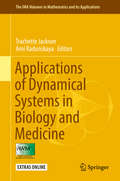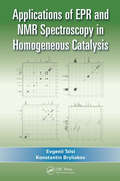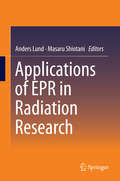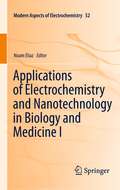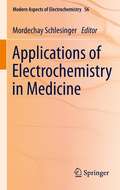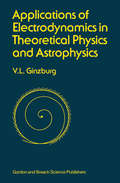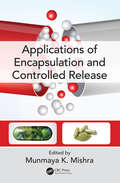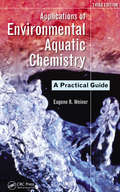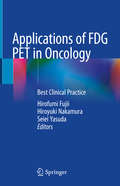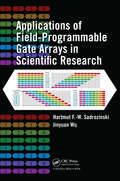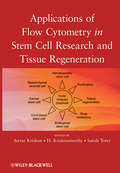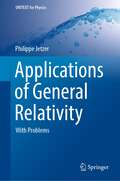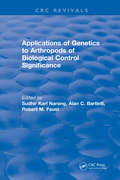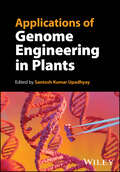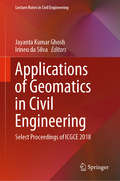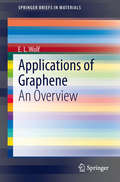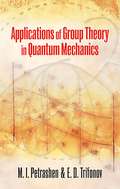- Table View
- List View
Applications of Computational Tools in Biosciences and Medical Engineering (Advanced Structured Materials #71)
by Andreas Öchsner Holm AltenbachThis monograph presents the latest developments and applications of computational tools related to the biosciences and medical engineering. Computational tools such as the finite element methods, computer-aided design and optimization as well as visualization techniques such as computed axial tomography open completely new research fields with a closer joining of the engineering and bio/medical area. Nevertheless, there are still hurdles since both directions are based on quite different ways of education. Often even the "language" is sometimes different from discipline to discipline. This monograph reports the results of different multi-disciplinary research projects, for example, from the areas of scaffolds and synthetic bones, implants and medical devices and medical materials. It is also shown that the application of computational methods often necessitates mathematical and experimental methods.
Applications of Computational Tools in Drug Design and Development
by S. N. Koteswara Rao G. Rajasekhar Reddy AlavalaThis book provides a comprehensive overview of the role of computers and computational tools at different stages of drug discovery and development. Designed to meet the needs of a beginner to advanced learner, the book provides the information on the tools, how they work, with the latest reports on applications in drug design, drug delivery and building network pharmacology models. Part I explores the pharmacological aspects, covering computational simulation of drug delivery at the molecular level, modeling for formulation design, and the revolutionary use of computational fluid dynamics in pharmaceutical processes. Specific applications such as pharmaceutical die filling processes, inhalation aerosol-based targeted drug delivery, and the development of inhalation compounds using in silico modeling tools are discussed. The use of computational tools in cheminformatics and their application in preformulation perspectives for drug delivery are also included. Part II expands the scope to include solubility prediction, absorption prediction, protein binding prediction, bio-permeability prediction, toxicity prediction, and metabolism prediction. It covers the identification of potential sites of metabolism in lead molecules and computer-assisted simulation studies to understand drug-polymer interactions. Recent advances in drug likeness screening using software and online tools are also reviewed. Part III focuses on specific therapeutic areas. <span class=
Applications of Computer Vision and Drone Technology in Agriculture 4.0
by Sanjeev Jain Siddharth Singh Chouhan Uday Pratap SinghThis edited book focus on two most emerging areas and covers the different aspects of computer vision and drone technology in the field of agriculture. It comprises various applications including segmentation/classification of plant diseases, monitoring of crops, grade/quality estimation of fruits/flowers/vegetables/crops, surveillance, soil deficiency estimation, crop/plant growth estimation, canopy measurement, water stress management, vegetation indices calculation, weed detection, and spraying, among other. It has 17 chapters contributed by experts in the field of computer vision, drone technology, deep learning, machine learning, artificial intelligence, image processing, agriculturist, and plant pathologists. The recent development of high-end computing devices and the adaptation of unmanned aerial vehicles has provided a mechanism to automate traditional agriculture practices. The on-field or aerial images captured using cameras are processed with the help of intelligent algorithms, and an assessment is drawn for further recommendations. This practice is efficient in provisioning an accurate, timely, and economical decision-making system to overcome the problems of agricultural field experts and farmers. This process is advantageous in increasing the quality and quantity of crop yields. This book serves as an excellent guide to students, researchers, scientists, and field experts in directing their work toward this domain and developing/designing models. Further, this book is useful for pathologists, biotechnologists, seed production specialists, breeders, market managers, and other stakeholders associated with underlying technology or market development from the public and private sectors.
Applications of Data-Centric Science to Social Design: Qualitative and Quantitative Understanding of Collective Human Behavior (Agent-Based Social Systems #14)
by Aki-Hiro SatoThe intention behind this book is to illustrate the deep relation among human behavior, data-centric science, and social design. In fact, these three issues have been independently developing in different fields, although they are, of course, deeply interrelated to one another. Specifically, fundamental understanding of human behavior should be employed for investigating our human society and designing social systems. Insights and both quantitative and qualitative understandings of collective human behavior are quite useful when social systems are designed. Fundamental principles of human behavior, theoretical models of human behavior, and information cascades are addressed as aspects of human behavior. Data-driven investigation of human nature, social behavior, and societal systems are developed as aspects of data-centric science. As design aspects, how to design social systems from heterogeneous memberships is explained. There is also discussion of these three aspects—human behavior, data-centric science, and social design—independently and with regard to the relationships among them.
Applications of Density Functional Theory to Biological and Bioinorganic Chemistry (Structure and Bonding #150)
by Mihai V. Putz D Michael MingosThe series Structure and Bonding publishes critical reviews on topics of research concerned with chemical structure and bonding. The scope of the series spans the entire Periodic Table and addresses structure and bonding issues associated with all of the elements. It also focuses attention on new and developing areas of modern structural and theoretical chemistry such as nanostructures, molecular electronics, designed molecular solids, surfaces, metal clusters and supramolecular structures. Physical and spectroscopic techniques used to determine, examine and model structures fall within the purview of Structure and Bonding to the extent that the focus is on the scientific results obtained and not on specialist information concerning the techniques themselves. Issues associated with the development of bonding models and generalizations that illuminate the reactivity pathways and rates of chemical processes are also relevant. The individual volumes in the series are thematic. The goal of each volume is to give the reader, whether at a university or in industry, a comprehensive overview of an area where new insights are emerging that are of interest to a larger scientific audience. Thus each review within the volume critically surveys one aspect of that topic and places it within the context of the volume as a whole. The most significant developments of the last 5 to 10 years should be presented using selected examples to illustrate the principles discussed. A description of the physical basis of the experimental techniques that have been used to provide the primary data may also be appropriate, if it has not been covered in detail elsewhere. The coverage need not be exhaustive in data, but should rather be conceptual, concentrating on the new principles being developed that will allow the reader, who is not a specialist in the area covered, to understand the data presented. Discussion of possible future research directions in the area is welcomed. Review articles for the individual volumes are invited by the volume editors. Readership: research scientists at universities or in industry, graduate students Special offer For all customers who have a standing order to the print version of Structure and Bonding, we offer free access to the electronic volumes of the Series published in the current year via SpringerLink.
Applications of Density Functional Theory to Chemical Reactivity (Structure and Bonding #149)
by D. Michael Mingos Mihai V. PutzThe series Structure and Bonding publishes critical reviews on topics of research concerned with chemical structure and bonding. The scope of the series spans the entire Periodic Table and addresses structure and bonding issues associated with all of the elements. It also focuses attention on new and developing areas of modern structural and theoretical chemistry such as nanostructures, molecular electronics, designed molecular solids, surfaces, metal clusters and supramolecular structures. Physical and spectroscopic techniques used to determine, examine and model structures fall within the purview of Structure and Bonding to the extent that the focus is on the scientific results obtained and not on specialist information concerning the techniques themselves. Issues associated with the development of bonding models and generalizations that illuminate the reactivity pathways and rates of chemical processes are also relevant. The individual volumes in the series are thematic. The goal of each volume is to give the reader, whether at a university or in industry, a comprehensive overview of an area where new insights are emerging that are of interest to a larger scientific audience. Thus each review within the volume critically surveys one aspect of that topic and places it within the context of the volume as a whole. The most significant developments of the last 5 to 10 years should be presented using selected examples to illustrate the principles discussed. A description of the physical basis of the experimental techniques that have been used to provide the primary data may also be appropriate, if it has not been covered in detail elsewhere. The coverage need not be exhaustive in data, but should rather be conceptual, concentrating on the new principles being developed that will allow the reader, who is not a specialist in the area covered, to understand the data presented. Discussion of possible future research directions in the area is welcomed. Review articles for the individual volumes are invited by the volume editors. Readership: research scientists at universities or in industry, graduate students Special offer For all customers who have a standing order to the print version of Structure and Bonding, we offer free access to the electronic volumes of the Series published in the current year via SpringerLink.
Applications of Differential Equations in Engineering and Mechanics
by Kam Tim ChauThis second of two comprehensive reference texts on differential equations continues coverage of the essential material students they are likely to encounter in solving engineering and mechanics problems across the field - alongside a preliminary volume on theory. This book covers a very broad range of problems, including beams and columns, plates, shells, structural dynamics, catenary and cable suspension bridge, nonlinear buckling, transports and waves in fluids, geophysical fluid flows, nonlinear waves and solitons, Maxwell equations, Schrodinger equations, celestial mechanics and fracture mechanics and dynamics. The focus is on the mathematical technique for solving the differential equations involved. All readers who are concerned with and interested in engineering mechanics problems, climate change, and nanotechnology will find topics covered in this book providing valuable information and mathematics background for their multi-disciplinary research and education.
Applications of Dynamical Systems in Biology and Medicine (The IMA Volumes in Mathematics and its Applications #158)
by Trachette Jackson Ami RadunskayaThis volume highlights problems from a range of biological and medical applications that can be interpreted as questions about system behavior or control. Topics include drug resistance in cancer and malaria, biological fluid dynamics, auto-regulation in the kidney, anti-coagulation therapy, evolutionary diversification and photo-transduction. Mathematical techniques used to describe and investigate these biological and medical problems include ordinary, partial and stochastic differentiation equations, hybrid discrete-continuous approaches, as well as 2 and 3D numerical simulation.
Applications of EPR and NMR Spectroscopy in Homogeneous Catalysis
by Evgenii Talsi Konstantin BryliakovThis book reviews advances in important and practically relevant homogeneous catalytic transformations, such as single-site olefin polymerizations and chemo- and stereo-selective oxidations. Close attention is paid to the experimental investigation of the active sites of catalytic oxidation systems and their mechanisms. Major subjects include the applications of NMR and EPR spectroscopic techniques and data obtained by other physical methods. The book addresses a broad readership and focus on widespread techniques available in labs with NMR and EPR spectrometers.
Applications of EPR in Radiation Research
by Anders Lund Masaru ShiotaniApplications of EPR in Radiation Research is a multi-author contributed volume presented in eight themes: I. Elementary radiation processes (in situ and low temperature radiolysis, quantum solids); II: Solid state radiation chemistry (crystalline, amorphous and heterogeneous systems); III: Biochemistry, biophysics and biology applications (radicals in biomaterials, spin trapping, free-radical-induced DNA damage); IV: Materials science (polymeric and electronic materials, materials for treatment of nuclear waste, irradiated food); V: Radiation metrology (EPR-dosimetry, retrospective and medical applications); VI: Geological dating; VII: Advanced techniques (PELDOR, ESE and ENDOR spectroscopy, matrix isolation); VIII: Theoretical tools (density-functional calculations, spectrum simulations).
Applications of Electrochemistry and Nanotechnology in Biology and Medicine I (Modern Aspects of Electrochemistry #52)
by Noam EliazThe study of electrochemical nanotechnology has emerged as researchers apply electrochemistry to nanoscience and nanotechnology. These two related volumes in the Modern Aspects of Electrochemistry Series review recent developments and breakthroughs in the specific application of electrochemistry and nanotechnology to biology and medicine. Internationally renowned experts contribute chapters that address both fundamental and practical aspects of several key emerging technologies in biomedicine, such as the processing of new biomaterials, biofunctionalization of surfaces, characterization of biomaterials, discovery of novel phenomena and biological processes occurring at the molecular level.
Applications of Electrochemistry in Medicine (Modern Aspects of Electrochemistry #56)
by Mordechay SchlesingerMedical Applications of Electrochemistry, a volume of the series Modern Aspects of Electrochemistry, illustrates the interdisciplinary nature of modern science by indicating the many current issues in medicine that are susceptible to solution by electrochemical methods. This book also suggests how personalized medicine can develop.
Applications of Electrodynamics in Theoretical Physics and Astrophysics
by David GinsburgTreats certain problems and methods of theoretical physics and astrophysics which are associated with microscopic and macroscopic electrodynamics and material concerning the theory of transition radiation and transition scattering.
Applications of Encapsulation and Controlled Release (Encapsulation and Controlled Release)
by Munmaya K. MishraThe field of encapsulation, especially microencapsulation, is a rapidly growing area of research and product development. Applications of Encapsulation and Controlled Release offers a broad perspective on a variety of applications and processes, including, up-to-date research, figures, tables, illustrations, and references. Written at a level comprehensible to non-experts, it is a rich source of technical information and current practices in research and industry.
Applications of Environmental Aquatic Chemistry: A Practical Guide, Third Edition
by Eugene R. WeinerProfessionals and students who come from disciplines other than chemistry need a concise yet reliable guide that explains key concepts in environmental chemistry, from the fundamental science to the necessary calculations for applying them. Updated and reorganized, Applications of Environmental Aquatic Chemistry: A Practical Guide, Third Edition pr
Applications of FDG PET in Oncology: Best Clinical Practice
by Hiroyuki Nakamura Hirofumi Fujii Seiei YasudaThis book provides up-to-date guidance on the use of FDG PET to assess the biological activity and treatment response of a wide range of malignancies, including, for example, lung cancer, breast cancer, head and neck cancer, gastrointestinal cancer, and malignant lymphoma. In the era of precision medicine, numerous new anticancer agents, such as molecular targeted agents and immune checkpoint inhibitors, have been developed to improve outcomes in cancer patients. FDG PET plays a key role in evaluating the effects of these novel treatments because it can detect changes in the metabolic activity of tumors before any reduction in their size is visible on other imaging modalities. Accordingly, FDG PET is of prognostic as well as diagnostic value, and allows prompt changes in patient management. The book is written by expert clinicians from Japan, where the universal public health insurance system ensures that FDG PET is widely used in routine oncological practice and cancer screening. It represents an unrivaled and comprehensive resource that will be of value for all healthcare professionals in the field of clinical oncology.
Applications of Field-Programmable Gate Arrays in Scientific Research
by Hartmut F.-W. Sadrozinski Jinyuan WuFocusing on resource awareness in field-programmable gate array (FPGA) design, Applications of Field-Programmable Gate Arrays in Scientific Research covers the principle of FPGAs and their functionality. It explores a host of applications, ranging from small one-chip laboratory systems to large-scale applications in "big science." The book first de
Applications of Flow Cytometry in Stem Cell Research and Tissue Regeneration
by H. Krishnamurthy Satish Totey Awtar KrishanA much-needed primer on the use of laser flow cytometry for stem cell analysisLaser flow cytometry is a powerful tool for rapid analysis of cells for marker expression, cell cycle position, proliferation, and apoptosis. However, no resources specifically address the use of this methodology for the study of stem cells; this is especially important as stem cell analysis involves specialized methods and staining procedures based on specific characteristics such as marker expression, cell size, drug transport, and efflux of the stem cells.Now, this book reviews these procedures, discusses the science behind them, and provides real-world examples to illustrate the usefulness of the methods. It brings together world-class experts in pathology, biophysics, immunology, and stem cell research, who draw upon their extensive experience with the methods and show examples of good data to help guide researchers in the right direction.Chapter coverage includes:Stem cell analysis and sorting using side populationFlow cytometry in the study of proliferation and apoptosisStem cell biology and applicationIdentification and isolation of very small embryonic-like stem cells from murine and human specimensHematopoietic stem cells--issues in enumerationHuman embryonic stem cells: long-term culture and cardiovascular differentiationLimbal stem cells and corneal regenerationFlow cytometric sorting of spermatogonial stem cellsBreast cancer stem cellsStem cell marker expression in cells from body cavity fluidsThis book is an essential resource for all graduate students, practitioners in developing countries, libraries and book repositories of universities and research institutions, and individual researchers. It is also of interest to laboratories engaged in stem cell research and use of stem cells for tissue regeneration, and to any organization dealing in stem cell and tissue regeneration research.
Applications of Fluid Dynamics: Proceedings of ICAFD 2016 (Lecture Notes in Mechanical Engineering)
by M. K. Singh B. S. Kushvah G. S. Seth J. PrakashThe book presents high-quality papers presented at 3rd International Conference on Applications of Fluid Dynamics (ICAFD 2016) organized by Department of Applied Mathematics, ISM Dhanbad, Jharkhand, India in association with Fluid Mechanics Group, University of Botswana, Botswana. The main theme of the Conference is "Sustainable Development in Africa and Asia in context of Fluid Dynamics and Modeling Approaches". The book is divided into seven sections covering all applications of fluid dynamics and their allied areas such as fluid dynamics, nanofluid, heat and mass transfer, numerical simulations and investigations of fluid dynamics, magnetohydrodynamics flow, solute transport modeling and water jet, and miscellaneous. The book is a good reference material for scientists and professionals working in the field of fluid dynamics.
Applications of General Relativity: With Problems (UNITEXT for Physics)
by Philippe JetzerThe aim of this textbook is to present in a comprehensive way several advanced topics of general relativity, including gravitational waves, tests of general relativity, time delay, spinors in curved spacetime, Hawking radiation, and geodetic precession to mention a few. These are all important topics in today's research activities from both a theoretical and experimental point of view. This textbook is designed for advanced undergraduate and graduate students to strengthen the knowledge acquired during the core courses on General Relativity. The author developed the book from a series of yearly lectures with the intention of offering a gentle introduction to the field. This book helps understanding the more specialized literature and can be used as a first reading to get quickly into the field when starting research. Chapter-end exercises complete the learning material to master key concepts.
Applications of Genetics to Arthropods of Biological Control Significance
by Sudhir Karl NarangWritten by experts in the fields of insect pest genetics, the genetics of biological control organisms, and the application of biological control, this book provides the first up-to-date summary of the genetic literature on the genetics of arthropod biological control agents. It identifies successful programs and also gaps and needs in research, research constraints, and possible research approaches in this important field of pest control. The power and applicability of new genetic and molecular biology methods have created new and exciting possibilities to greatly improve the effectiveness of traditional biological control programs. This book provides essential information about the state-of-the-art application of these new methods. It explains how biological control procedures can be improved, covers methods for selecting pesticide-resistant strains of natural enemies, and looks at methods for maintaining genetic diversity and quality control during the rearing of biological control agents in the laboratory. The book also provides information regarding the application of powerful PCR methods for taxonomic identification of strains and species of biocontrol agents.
Applications of Genome Engineering in Plants
by Santosh Kumar UpadhyayApplications of Genome Engineering in Plants Understand the keys to creating the food of the future Genome engineering in plants is a field that has made enormous strides in recent years. In particular, the CRISPR-Cas system has been used in a number of crop species to make significant leaps forward in nutritional improvement, stress tolerance, crop yield, and more. As scientists work to meet global food needs and foster sustainable agriculture in a changing world, genome engineering promises only to become more important. Applications of Genome Engineering in Plants details the history of, and recent developments in, this essential area of biotechnology. It describes advances enabling nutritional improvement, nutraceuticals improvement, flavonoid enrichment, and many more crop enhancements, as well as subjects such as biosafety and regulatory mechanisms. The result is a thorough and essential overview for researchers and biotech professionals. Applications of Genome Engineering in Plants readers will also find: Chapters on trans-gene free editing or non-transgenic approaches to plant genomes Detailed discussion of topics including nanotechnology-facilitated genome editing, engineering for virus resistance in plants, and more Applications of genome editing in oil seed crops, vegetables, ornamental plants, and many others Applications of Genome Engineering in Plants is ideal for academics, scientists, and industry professionals working in biotechnology, agriculture, food science, and related subjects.
Applications of Geomatics in Civil Engineering: Select Proceedings of ICGCE 2018 (Lecture Notes in Civil Engineering #33)
by Jayanta Kumar Ghosh Irineu Da SilvaThis book comprises select proceedings of the First International Conference on Geomatics in Civil Engineering (ICGCE 2018). This book presents latest research on applications of geomatics engineering in different domains of civil engineering, like structural engineering, geotechnical engineering, hydraulic and water resources engineering, environmental engineering and transportation engineering. It also covers miscellaneous applications of geomatics in a wide range of technical and societal problems making use of geospatial information, engineering principles, and relational data structures involving measurement sciences. The book proves to be very useful for the scientific and engineering community working in the field of geomatics and geospatial technology.
Applications of Graphene: An Overview (SpringerBriefs in Materials)
by E. L. WolfGraphene is presented and analyzed as a replacement for silicon. The Primary focus is on solar cell and CMOS device technologies, with attention to the fabrication methods, including extensions needed, in each case. Specialized applications for graphene within the existing silicon technology are discussed and found to be promising.
Applications of Group Theory in Quantum Mechanics (Dover Books on Physics)
by M. I. Petrashen J. L. TrifonovGeared toward postgraduate students, theoretical physicists, and researchers, this advanced text explores the role of modern group-theoretical methods in quantum theory. The authors based their text on a physics course they taught at a prominent Soviet university. Readers will find it a lucid guide to group theory and matrix representations that develops concepts to the level required for applications.The text's main focus rests upon point and space groups, with applications to electronic and vibrational states. Additional topics include continuous rotation groups, permutation groups, and Lorentz groups. A number of problems involve studies of the symmetry properties of the Schroedinger wave function, as well as the explanation of "additional" degeneracy in the Coulomb field and certain subjects in solid-state physics. The text concludes with an instructive account of problems related to the conditions for relativistic invariance in quantum theory.
